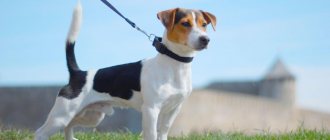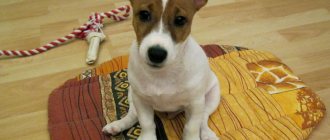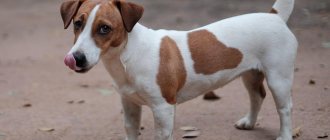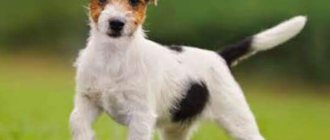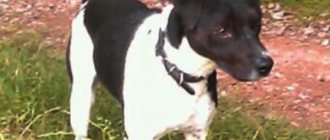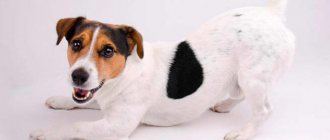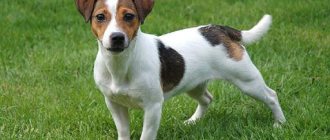The Jack Russell Terrier today is more often perceived as companion dog. But for those who decide to choose a representative of this breed as a pet, it is important to consider that this is not a funny toy, but a brave and capricious fox hunter. Dogs have a need for constant physical activity, require a competent approach to their socialization.
History of the origin of the breed
The breed is named after the English clergyman who selected it. John Parson Jack Russell, was fond of hunting, was a breeder of fox terriers. In 1873, he founded the club and participated in the development of breed standards.
White terriers were in demand among hunters because they cannot be shot if confused with a badger or a fox; their ears protect the ear canal from dirt during burrow hunting. The ancestor of the breed is considered to be a bitch nicknamed Trump. Jack Russell bought her from a market trader because he was fascinated by her unusual appearance. The dog was white with red spots and looked like a fox.
From this moment selection work began. Most likely, the ancestors of the Jack Russell Terrier were old-type fox terriers, English terriers, Welsh corgis, and bulldogs. The breeder believed that the desire to kill and aggression did not correspond to the principles of traditional British hunting.
The dog was not intended to mutilate game. He had to drive her out of the hole by barking. The little hunter's sonorous voice is due to the admixture of beagle blood. The priest conducted a strict selection, aimed primarily at improving the working qualities of the dog, caring little about its appearance.
Neighboring farmers learned about Russell's cunning and hardy dogs. The breed began to spread. In 1974, the priest acted as a judge for the only time at an exhibition of his terriers. He himself considered this breed to be exclusively working, not created for showing.
However, hunters appreciated the advantages of the Jack Russell Terrier. Dogs began to be used to catch foxes, badgers, and game birds. In horse hunting, dogs were used to follow the bloody trail to search for wounded deer or roe deer.
Some have tried to improve the fearless Priest Terriers by adding aggressiveness to them by crossing them with Bull and Terriers. With the ban on dog fighting in the mid-19th century, experimentation ceased.
Some traces of them have survived to this day in individuals with black spots. They look rougher in comparison with their white-red counterparts, have more massive heads and a straight bite.
There was no information about the Jack Russell Terrier dog breed outside Foggy Albion. The dogs gained fame in the 20th century, when several individuals were taken to Australia. Dog handlers from a distant continent liked the funny, brave dogs. They added local terrier blood to them, improving the appearance of British working dogs.
Jack Russell Terriers appeared in Russia in the late 1990s, but were viewed with skepticism by dog breeders. They were mistaken for “rejected” short-haired fox terriers.
After the release of the film “The Mask”, where the Jack Russell Terrier was filmed as the dog Milo, dogs began to be in demand. In 2003, the first National Club of Breed Fans was opened.
Today this is one of the most popular breeds among residents of megalopolises, who appreciate its original appearance, ease of care, and cheerful disposition.
Strength of genotype
It is noteworthy that the genotype of each color has its own strength and can either dominate or become recessive. The strongest color is black. It suppresses all other colors. In second place is the brindle color, dominant over black and tan and red and white. Red and white suppresses black and tan, but the dog can be its carrier. Black and tan is the weakest color in the Basenji genotype.
It may not manifest itself, but some individuals pass it on to subsequent generations. In order for the offspring to be of this color, the carrier must be mated only with a black and tan individual. It is noted that mating a brindle with a black and tan increases the risk of producing offspring with unregistered colors (most often trindle).
The Basenji's color genetics are unusual, but generally predictable. Each dog passes on from generation to generation 2 genes responsible for the color scheme. From crossing black and tan parents, puppies of the same color will be born, but if one parent is brindle, then brindle or red and white offspring will be born. Each genotype has an individual strength, with black being the most predominant shade. Displays of unrecognized colors are also common.
Description of the breed with photos
The final standard for the Jack Russell Terrier breed was approved only in 2012. Dog handlers classified him as a small but hardy hunting dog.
The purebred Jack Russell meets the following characteristics:
- the body is slightly elongated, flexible, strong;
- the back is strong, with a slightly convex loin;
- chest deep;
- muscular limbs;
- nose is black;
- lips fit tightly to teeth, painted black;
- cheeks with developed muscles;
- ears raised, tips tilted forward;
- The eyes are medium-sized, dark, almond-shaped, with a black edge. Convex, with non-closed eyelids are considered a defect;
- powerful neck;
- the tail is set high, straight, and takes a vertical position when moving;
- the jaws are powerful and wide;
- scissor bite.
According to the description of the breed, the dog's gait is light and springy. In general, Jack Russell Terriers give the impression of being strong, active, emotional animals. Sluggish movements are considered a fault. Breed defects include aggression or cowardice.
Size and weight
Jack Russell females and males do not differ much in size. Their height is from 25 to 30 cm . Weight should be proportional: 1 kg for every 5 cm of height.
At first glance, representatives of the Jack Russell Terrier breed look disproportionately long. This shape was deliberately given to the dog by breeders so that the animal could cope with the tasks of burrow hunting.
Color and coat type
Based on coat type, Jack Russell Terriers are divided into three groups:
- smooth-haired with a dense undercoat, a hard pile adjacent to the skin, more suitable for hunters. The fur does not prevent the dog from moving in the hole. Soft to the touch, thin hair is considered a defect;
- wire-haired type has coarse, long hair that sticks out slightly to the sides. This type of dog looks shaggy;
- intermediate view Jack Terrier is called "broken", which means “broken” in English. These dogs have the longest coat, with kinks in several places. The eyebrows and beard of these dogs practically do not grow.
Attention: it is possible to determine what type of coat a puppy will have no earlier than 3 months of age.
Even an experienced breeder cannot always tell from a newborn Jack Russell what type it is. One litter can contain dogs of different species .
The main color of the little hunters is white with spots of black or different shades of brown. The spots are round in shape and should not occupy more than 30% of the animal’s body.
Two-color
Bicolor is the color of a Beagle, consisting of two colors - white (closer to cream) and a shade of red. The pigment responsible for redness manifests itself in different intensities:
- red;
- ginger;
- citric.
The division of tones is conditional; there are transitional variations between them. The standard allows all shades from red to light lemon. It is bicolor that is most popular in the UK.
Red is considered the rarest. Its saturation is often compared to brick, but the color is called “mahogany” in another way. The remaining shades between red and lemon are variations of the red tone. Very often the light red color is mistaken for the lemon Beagle color.
Bicolor puppies are most often born completely white and darken closer to the age of one year. However, there is still a way to determine the exact color color: the darker the nose, the lighter the coat. The lemon white Beagle has nose pigment closer to black. Red and white dogs have a more light brown nose.
Sometimes the color of the nose can also change color (from light to dark). This can happen in bitches, in whom the phenomenon depends on the hormonal cycle.
White - red
It is the white and red one that is most often found among bicolor Beagles. It exists in a wide variety of variations: from dark, rich tones to almost pale cream shades.
Interpretations of the red bicolor are very often subject to doubt and controversy. It is easy to confuse it with the unique lemon color or classify the bright shade as a rare red and white. Only experienced beagle breeders are able to independently determine the color of a dog.
It is incorrect to consider the dominant color of the Beagle to be pure white. It is slightly darker than snow white and closer to a light cream or creamy shade. The combination of light cream color and white is called lemon.
Citric
Lemon color is considered the unique color of the breed. It is very difficult to identify, especially for a novice breeder. Lemon color is achieved by maximizing the lightening of the gene responsible for dark colors. Puppies with this color have a dark (almost black) nose from birth.
Lemon shade is a pale cream color that is only slightly darker than base white. A more saturated tone already belongs to red-and-white, although many mistakenly classify it as “lemon”. The principle of determination is simple - the lighter the red pigment, the closer it is to lemon.
Speckled or speckled
Specks are one of the options for displaying tricolor and bicolor. It is characterized by the presence of small black or red spots on the entire body (or in certain areas), as in the photo. The spots can form in large numbers (dense) or at a great distance from each other (sparse). Speckled is not a spotted variety and has nothing in common with the blue merle (merle) color.
Discoloration is genetically determined. You can recognize it in newborn puppies: their paw pads are never pink. The real mark appears already by 4-5 days from birth. Sometimes puppies acquire it at 6-8 weeks.
Motley
The variegated color occupies an ambiguous position. Essentially, it is a combination of two colors, but in different shades. Officially, variegated varieties are recognized only in the UK and the FCI. In total, they identified 3 varieties:
- badger motley (the rarest and most intense, black color predominates);
- hare motley (dominance of red color);
- lemon variegated (lightest).
Most pieds are recorded in the UK, but this does not mean that they are only found in one country. This variety is not rare and sometimes you need to look closely to see the variegated color in the muted tricolor.
Beagle breeders have never come to a consensus on which color combination to accept as a variegated color. Some argue that the presence of “agouti” is sufficient (zonal coloring - the tip of the hair is black, the rest is brown). Others believe that it is necessary to “mix” the brown and black hairs on the Beagle’s body.
With a variegated color, there is no pure snow-white color. It is more reminiscent of creamy or creamy (as is the case with standard bicolor). The color smoothly flows into another shade, which is similar to the usual classic tricolor.
Health and illness
Breeders carefully monitor the gene pool, but there are still some hereditary diseases inherent in this breed.
The most common of them:
- cataract;
- displacement of the lens. Not common, appears at the age of 3 or 8 years;
- deafness;
- hip dysplasia;
- ataxia (irregularity of muscle movements);
- myasthenia gravis (muscle weakness)
- necrosis of the femoral head (Legg-Calvé-Perthes syndrome);
- displacement of the kneecap;
- Von Willebrand disease (spontaneous bleeding).
Regular visits to the veterinarian and the owner’s attention to the pet will help minimize risks.
Lifespan
Jack Russell Terriers are naturally endowed with a strong immune system and good health . With proper care, their life expectancy is 13-16 years .
In order for your pet to remain healthy for many years, you need to take into account the characteristics of this breed when caring for it. The hunting instincts of dogs push them into contact with wild animals, so timely vaccination of the pet against deadly infections is very important.
Locus T
Genes T > t. The genes of this locus determine the presence or absence of small pigmented spots on white areas. This phenomenon is called teak spotting or speckling. The dominant gene T is speckled, the recessive gene t is the absence of speckling. The T gene can only appear if the dog has white markings (it is simply not visible on a colored one (which makes detection difficult) and is the result of a secondary wave of pigmentation, since it appears in puppies only 2-3 weeks after birth.
It should also be noted that the T locus is responsible only for the formation of pigment cells, and what pigment these cells will further produce depends on the color-forming loci. For example, on the body of an Au-adult individual, the markings will appear in the form of small spots (red in a bicolor dog), while on the body of a dog with a tan At-At color, the markings will be two-colored, in the tan zone - red, on the rest - black. On the body of a saddle-backed Asa dog there is red on the paws, shoulders, head, neck, and black in the saddle area (back).
Speckling in the DRT breed is not prohibited by the standard, but is considered an undesirable trait, and therefore is not welcome, and certainly not worth breeding when both parents are spotted.
Character and intelligence
Jack Russell Terriers have a cheerful, playful disposition. At the same time, they are decisive and independent. These are not lap dogs; they prefer constant movement and frequent changes of environment.
The pet must always be busy, otherwise the fidget will find entertainment for itself. He will begin to spoil things, dig holes in the floor or upholstered furniture.
If you do not give your dog enough attention, it may develop nervous disorders and the animal will become uncontrollable.
Many terrier owners “calm down” their baby with long walks and exhausting running after the ball. After active games, the pet gets tired and behaves more calmly at home. The playfulness of such dogs lasts their entire lives.
A characteristic feature of Jack Russell Terriers is their “talkativeness”. Sociable dogs make sounds almost constantly: from weak squeals to loud barks.
They react with their voice to extraneous sounds, the doorbell and others. Because of this behavior of the pet, the owners may have problems in relations with their neighbors.
The Russell Terrier is an owner, he does not tolerate people taking his bowl, toys, or bedding. The jealous attitude also extends to the owner. The dog will vehemently protest if the owner begins to devote time to other pets.
Unlike many other breeds, the Jack Russell Terrier does not require a “leader” owner ; he can choose one of the family members as his favorite.
When walking, you need to carefully monitor your dog. The little hunter is distinguished by his unbridled courage and can enter into a fight with a dog much larger than himself . This may result in your pet being seriously injured.
Attitude towards children and others
The restless, cheerful and brave Jack Russell Terrier loves children very much and takes an active part in all their games. But families with children under 3 years old should not have a representative of this breed.
Dogs do not tolerate careless treatment. If a dog is pulled by the tail or ear, it will snap, which can frighten the baby. In addition, with such a pet it will be problematic to follow the baby’s daily routine; the dog will wake him up with loud barking. This breed does not show direct aggression.
Jack Russells are happy to play even with other people's children, but they are wary of adult strangers.
Attention: funny dogs are used in complex therapy of children suffering from autism and cerebral palsy.
They are aggressive towards other dogs. If two terriers live in the house, it is better not to leave them alone. Representatives of the breed jealously guard their territory and can fight. We must not forget that this is a hunting breed.
You cannot breed hamsters or rabbits at the same time as a Jack Russell - dogs perceive them exclusively as prey.
The terrier should only be taken outside on a leash. He may chase the cat, get lost, or get hurt.
Only early socialization and proper upbringing of the pet will help reduce the risk that the dog will get into trouble.
Education and training
Jack Russells are endowed with a sharp, lively mind. They easily remember commands and enjoy training, but only as long as they are interested in them. Dogs love active entertainment; exercise in the form of a game will quickly bring the desired result.
It is important to remember that terriers are very stubborn . When raising a dog, the owner will need patience and perseverance.
Attention: the breed is easy to train, suitable for beginner dog breeders.
Jack Terrier puppy training should begin at two months of age. The baby needs to be taught the rules of behavior in the house.
In order not to take the dog out for a walk in bad weather, he is taught to relieve himself in a special diaper.
The puppy should be placed there immediately after sleep, 10 minutes after eating, when he begins to worry and sniff the floor. During bowel movements, your pet should not be scolded or moved - such mistakes can provoke behavioral disorders. Every time after the dog pees on the spot, he must be encouraged.
The second important point is to wean the puppy from biting. For him, this is part of the game, not aggression. You need to demonstrate to the dog that his actions are causing pain. To do this, you can scream after the bite and leave the room for a while.
Jack Russells strive to please their owner, so they will try not to upset him. When a baby's teeth change and his gums itch, he needs to be provided with a sufficient number of toys.
The third task of the owner is to make sure that the dog does not bark when left alone at home. To do this, you need to leave the room, increasing the time you are absent. Return only when the puppy is silent. You should be patient so that the terrier does not think that the owner is returning to his voice.
A well-mannered dog must follow basic commands:
- "place";
- "ugh";
- "to me";
- "sit";
- "lie";
- "near".
The Jack Russell must be trained correctly. The first workouts should last a couple of minutes, with a gradual increase in exercise time to half an hour. You can start mastering a new command only after mastering the previous one.
For each completed task, the puppy is rewarded with a treat or praise. You can't hit the dog. It is enough to say the command in a stern voice, pause for a second and repeat the order.
Attempts to dominate must be stopped immediately. The dog should not eat from the common table, jump on the bed, or put its front paws on people. The dog must calmly give toys and food to the owner. You can’t give your baby your old things to tear apart, otherwise in the future the terrier will spoil anything, and it’s extremely difficult to wean him from doing this.
The exhibition animal must calmly accept the judges' examination of the teeth, joints, and testicles. Aggression in this case is the reason for disqualification.
For shows you need to learn a special step. It is necessary for the dog to walk calmly at the owner’s left leg with a wide, smooth stride with a straight back.
To train for exhibition running, you should run next to the dog, holding him on a leash, jerking to stop jumping. The desired pace is encouraged by voice.
The problem is training a fidget to do a show stand, in which the Jack Russell Terrier needs to freeze for a couple of minutes. To do this, you need to praise and encourage with treats long-term immobility after the “ring” command.
Locus E (Extension)
The order of dominance is Em > Eg > E > Eh > e. According to the results of genetic studies, five genes are located in the E locus. The most dominant Em gene is the mask color, the eumeline mask on the dog’s face. The next most dominant gene is Eg - the “reverse” mask - a specific lightening on the face, known in two breeds: Afghan and Saluki (domino and grizzly colors). Gene E – normal distribution of eumelanin. The Eh gene is the sable color of English Cocker Spaniels. Gene e – recessive red color.
The DRT breed has only two genes of this locus - Em and E. The presumptive existence of a mask color in the breed, identified by existing external characteristics and the nature of their inheritance, still requires additional genetic examination, since the presence of Au-fawn color often gives characteristic blackening in various breeds on the face, which can often be confused with a mask color. The recessive red color E is not common in the breed, but individual individuals are found and, alas, more and more often...
At first glance, the recessive red ee is similar to the dominant Au-red, and it is not always possible to distinguish these two colors in an adult dog, although unlike the Au-red, the ee-red will never have the slightest admixture of eumelanin (black pigment). But since with Au-red in an adult the human eye cannot always see the individual few granules of black pigment in the coat, almost 100% results are obtained by examining puppies in the first weeks of life. Au-red puppies are always born with an admixture of black/brown hair (as if the puppies were dirty), and ei-red puppies are pure red from birth. Based on this distinctive feature and because the breed never produces red puppies from two tan individuals (At-At), although the result of the birth of tan individuals (At-At) from two Au-red individuals is quite expected, we can conclude that her-red color is fortunately it did not penetrate the breed.
This color is epistatic to all other colors, that is, the combination of its two genes in the genotype always gives a red color, regardless of which genes are located in other color-forming loci.
Recessive red color is found in the following breeds: English Setter, Irish Setter, Irish Terrier, Scottish Setter, Beagle, Dalmatian, Labrador, Golden Retriever, Labrador, Pointer, Poodle, English and American Cocker Spaniels, Russian Spaniel, Chow Chow, Field spaniel, scotch terrier.
But a lot of time has passed since then, and the periodically emerging fashion for rare colors pushed breeders in some countries to make interbreed matings, and now genetic examination finds the gene in breeds where there was no recessive red color at birth. The spread of the e gene across different breeds very clearly demonstrated the level of control of purebred breeding on the part of breeders.
Pros and cons of the breed
Before you get a Jack Russell Terrier, you need to consider the positive and negative aspects of this breed.
We present the main ones in table form.
| pros | Minuses |
| cheerful, playful disposition | restlessness |
| sharp mind | ability to manipulate |
| the hunter's instinct is developed | does not get along with other animals |
| easy to care for | constant shedding |
| ability to train | stubbornness |
| bravery | desire to fight |
| good guard | loud barking |
| devotion to the owner | jealousy, possessiveness |
| loves children | a baby can be frightened by barking |
In order for Jack Terriers to demonstrate positive character traits to a greater extent, it is important to provide them with proper education and care.
Hunting qualities
Like many other members of the terrier group, Jack Russell Terriers were bred to hunt small, burrow-dwelling game. Of course, terriers do not have enough speed and power for tracking and pursuit, but English foxhounds or other hounds did an excellent job with this task, but in penetrating an underground shelter and in a fight forcing the “fugitive” to leave it, the persistent and compact hounds have no equal strong guys.
It was already mentioned above that Jack Russell Terriers gained their reputation as excellent burrow dogs not for their ferocity, but for their clear voice and high intelligence. They not only understood the hunters’ strategy in a given situation, focusing on various horn signals, but also made their own decisions, which helped save energy without sacrificing efficiency.
Since their introduction, "jacks" have been an integral part of rural life in Great Britain. However, since 2002 in Scotland, and since 2005 in England and Wales, fox hunting has been officially banned, although for many it was part of the country's cultural heritage. Badgers are also now protected by conservation organizations. In southern Spain there is still a hunting area where it is possible to pursue game on horseback, but in most European countries the tradition is fading into history due to the lack of uninhabited areas with suitable landscape.
But innate instincts cannot be canceled as easily as centuries-old rituals, so four-legged “city dwellers” do not miss the opportunity during a walk to chase a passing cat or dig an impressive hole in the roots of trees from the nearest park.
Maintenance, care and nutrition
The ideal place of residence for a Jack Russell Terrier is a country house with a garden plot where the dog can frolic and bark to its heart’s content.
It is important that the area is surrounded by a high fence. Even in this case, you will have to make sure that the dog does not dig under the fence.
You can keep your pet in a city apartment when it is possible to provide him with long, active walks.
In maintaining hygiene, the main difficulty is caring for the pet’s specific coat, especially if it belongs to the long-haired variety. Such dogs need to be trimmed regularly (pluck out dead hairs).
Russell terriers with any long coat should be combed and brushed with a hard mitten (or a damp towel). You shouldn't bathe your dog often. Constant washing destroys the hair's natural oils and spoils the hair. Dogs must be bathed before the exhibition, bitches - after estrus.
The Jack Russell Terrier's ears are cleaned weekly with a sterile swab containing a special solution, which can be purchased at a veterinary pharmacy or pet store. The ear canal itself cannot be cleaned; only the visible part of the cartilage needs to be wiped. After the procedure, the ear is blotted dry with a clean napkin.
Nails should be inspected regularly and trimmed if necessary to prevent damage to the paw pads.
If the dog's eyes become dirty, wipe them with a cotton swab moistened with a weak solution of boric acid. If the whites and eyelids are red, your pet most likely has conjunctivitis. In this case, you should contact your veterinarian as soon as possible and treat your eyes only with the medications he prescribes.
Whether a Jack Russell Terrier's tail needs to be docked depends on what the dog was purchased for. The procedure was carried out for hunting dogs for safety reasons, to avoid injury to the animal in the fox hole.
Nowadays, dogs are more often used as companions; there is no need for surgical manipulation. The decision to dock the tail or not must be made by the owner himself.
The operation is best performed at the age of 3-10 days. At this time, the circulatory system and nerve endings of the limbs are not yet fully formed, the procedure, as well as the rehabilitation period, will be almost painless. You can dock an older pet, but not older than six months. In this case, you will have to use anesthesia.
In order for your dog to grow up healthy, it is important to provide him with proper nutrition. Jack Russell can eat commercial food or natural food. In the first couple of weeks, it is advisable to feed the puppy the same thing that he ate from the breeder. Your pet should be transitioned to a new diet gradually, following certain rules:
- dry food in a soaked form must first be mixed into canned food or homemade food;
- add any new product little by little, starting with a teaspoon;
- translation into “natural” should start with meat broths, then include vegetables, then cereals;
- Give vitamins only in consultation with a veterinarian.
The diet of an adult dog should include the following foods:
- beef;
- buckwheat;
- pumpkin;
- boiled chicken;
- beet;
- rice;
- carrot
- dairy products;
- thoroughly boiled heart (the terrier should not be given other offal products);
- zucchini.
Those who prefer to feed their pet industrially produced food should choose at least premium products. To feed Jack Russell Terriers, breeders recommend using food from the following brands:
- Canide;
- Innova EVO;
- Akana;
- Artemis Maximal Dog;
- Orijen.
Dry food is good because it contains all the vitamins and microelements the animal needs.
It is forbidden to feed your pet food from the common table, fatty, fried, hot, spicy dishes, as well as sweets.
What determines coat color?
In mammals, black and yellow pigments are produced, which are contained in granules of hair hairs. They determine the color of the animal’s coat.
Black Pekingese - the color is dominant. But, when crossing black Pekingese with any other colors, it is not a fact that the puppies will be the same black. Black dogs carry genes that cause the development of different colors. A litter may produce puppies that are completely different in color.
The Pekingese has a black and white coat - the color depends on the distribution of coloring pigments in the hairs of the coat. The location of the pigment can be ring-shaped. In this case, the hairs are colored unevenly.
The black color often allows white markings on the paws, forehead and chest. The color has different shades. The hair is characterized by a red color with dark tips of varying lengths.
With a short dark tip, the red color will predominate. If the dark pigment at the end of the hair is longer, the red color will appear darkly rippled, almost black or gray.
The repetition of such rings, i.e., the alternation of yellow and black pigment, forms a zonal coloration. If the black pigment is located at the tip of the hair, and yellow at the base, then the coat will be sable, deer or red with blackening, according to the terminology of French dog handlers.
The ring arrangement of pigments can be of different widths. If distributed evenly, the color will be zoned gray. If the yellow stripes in the ring are wider, then it is reddish-gray.
It is quite difficult to separate colors in puppyhood; the color is defined as gray-fawn or fawn. More often this color is found in combination with a black mask.
The pigment pheomelanin comes in a variety of shades - from yellow to red. The presence of pheomelanin color determines the intensity of the red color common among Pekingese - from light fawn to red-red.
Sable puppies change coat color as they age. If at birth they are dark gray or black, then with age the undercoat becomes lighter, and the growing outer coat turns red.
When babies are immediately born red, only the color intensity changes with age. Red Pekingese can be of any color. When mating with the same red dogs, you can get a wide variety of colors in the litter.
The gray color of the Pekingese varies from light to dark brown, almost black.
Such a variety of shades is found in the guard hair and in the undercoat. This color is also called zone gray among Pekingese.
Dog handlers in Great Britain and the American Kennel Club call this coloring Wild sable, Wolf sable (wild sable or wolf).
White Pekingese are, in fact, very bleached red individuals. The combination of some genes leads to a strong lightening of the red color, even white. This genetic factor is also responsible for the cream color of the Pekingese. The bleached undercoat enhances the impression of white.
The black and tan color is characterized by a constant arrangement of tan marks in strict places: above the eyes, on the cheeks, chest, around the anus, on the inner thighs, on the paws. It is difficult to see the clear outline of the tan contour of the Pekingese due to the long hair and shortened muzzle.
The color of tan marks depends on pheomelanin and ranges from light yellow to dark red.
White spotting can appear in the form of individual white spots. Or it is the main white color of the Pekingese, on which there are spots of a different color. This is caused by depigmentation genes or a break in pigment on the dog’s body. Usually the spots do not merge with each other.
How to choose a puppy
A purebred puppy should only be purchased from specialized nurseries or from trusted breeders. The cost of such a Jack Russell Terrier is 500-1200 dollars, depending on the title of the parents.
You can, of course, purchase a puppy without documents from an ad on the Internet for $100-300. This should not be done, as there is a high risk of getting a defective or diseased individual.
Attention: parental championship does not guarantee that all animals in the litter are show class.
When choosing a Russell Terrier puppy, you need to pay attention to the following characteristics of the animal:
- mobility, lack of fear. Lethargy or cowardice are disqualifying characteristics for this breed;
- the color is predominantly white;
- no extra fingers;
- The teeth are straight and white. Scissor bite;
- Males have two testes completely descended into the scrotum.
Any elite puppy has a brand (or microchip), a veterinary passport, and a medical certificate.
It is better to buy a dog for exhibitions at 5-6 months. By this age, all breed characteristics are fully formed in the baby. It is advisable to purchase a working dog at the age of two months in order to raise it “for yourself.”
If you are not very well versed in the breed, carefully study the standards before purchasing and consult with specialists.
Tricolor
Dogs with a tricolor are born black and white. The reddish or brownish markings are fully formed when the dog is one year old. Sometimes puppies are born with three shades at once. Young animals may have white hairs in the black zone, but this feature is temporary.
Black-red-white. The most common color variant of the Beagle, which is why it is called “classic” or “traditional”. The most common color is anthracite-fiery white. The colors are evenly distributed throughout the body, the boundaries of each shade are blurred. In contrast to the “classics” there is a weakened (blurred) tricolor. There are quite a lot of variations of weakened shades.
Blue tricolor
The blue tricolor is due to genetic characteristics. The gene “lightens” the dog’s colors, turning black into gray and brown (red) into cream. When the color is blue, the iris of the eyes also changes. It becomes lighter - closer to yellow. The nose also acquires a lighter pigment (gray or slate). Often, it is the shade of the nose that can determine the blue color of a Beagle puppy. The color is otherwise called smoky, gray or silver.
A genetic mutation can lighten the black gene to light gray shades. The silver color is called lilac tricolor (“khaki” or “mocha”). Sometimes puppies are born traditionally tri-colored, but later the white coat becomes covered with small spots. This feature is called blue-freckled color.
Chocolate
Chocolate (liver) tricolor also belongs to the weakened type. In this case, the black gene takes on a brown tint, completely replacing all dark tones. The chocolate version is characterized by the fact that it goes in combination with the light green eyes and brown nose of the Beagle. The black color is lightened to varying degrees: from dark liver to almost creamy shades.
A variation of the chocolate tricolor is the lilac color. “Purple Chocolate” is unique in that the brown tint goes together with blue. This combination forms a whole shimmer of colors, which is called “isabella”. The chocolate (liver) color is not recognized by the FCI and therefore not in the UK. All puppies of this color are completely discarded and are not allowed for further breeding. The situation is the opposite in the USA and Canada - the color is officially registered, and “liver” Beagles often receive high marks from experts.
The chocolate tricolor is considered a disqualifying fault for two reasons: it may indicate that the dog is not purebred, or that the individual has poor vitality. The accumulation of recessive genes can lead to subsequent genetic abnormalities in other generations.
Spotted
The spotted color belongs to the tricolor group. In other words, it is called torn or open. The dominant color is white, which divides the “traditional” version of the tricolor, turning it into spots. Sometimes white covers almost 80% of the dog's body, leaving a few small black or tan colored markings on the Beagle.
Video about the breed
The choice of breed is crucial, determining the future life of not only the dog, but all members of the family into which it ends up. Phlegmatic people who like to spend time in a quiet home environment should not get a Jack Russell Terrier - a lack of activity will negatively affect the dog’s character, behavior, and health.
This breed is for those who love sports, walks, and outdoor games. In a comfortable environment, little hunters will show their best qualities and become a devoted friend and reliable companion for a loving owner in any life situations.

